




Coupled with digital expertise, TorqIQ® technology brings a new degree of freedom to engine control strategies which will enable cleaner use of today’s fuels, as well as a transition path to future carbon-free fuels.
Bowman’s eTurbo Systems, powered by TorqIQ® technology, can also be used to improve the performance and efficiency of fuel cells.





Optimising the performance, size and high frequency losses.
Optimising performance, size and aerodynamic losses both of the turbine and within the machine.
Avoiding resonance which could create unacceptable vibration.
Managing high centrifugal forces generated by high rotational speeds.
Designing all other aspects of the machine, from bearing design and life to overall CAD and drawings.
Providing the main power component and control design.
Managing heat generated by mechanical and electromagnetic losses.
Providing the intelligence of the power electronics and a rich source of IP.
Providing all other practical design necessary to produce a product.
If you are interested in becoming a customer, or you are interested in partnering with us on eTurbo Systems, please get in touch.





The addition of eTurbo Systems, powered by Bowman’s TorqIQ® technology, can solve both of these issues.

Away from this design point, the inflexibility of the mechanical turbocharger means compromises are made and steady-state performance is typically suboptimal.




An electric compressor (eCompressor) is a compressor driven by a high-speed electric motor connected directly to its shaft.



Similarly eCompressors can also be used to boost fuel cells, however in this case the compressor delivers all of the air requirement for the fuel cell under all conditions whether steady-state or dynamic.










An electric turbine (eTurbine) is a turbine directly coupled to a high-speed electric alternator.








An electric turbocharger (eTurbo) is achieved through the addition of a high-speed electric motor/generator directly to the turbocharger’s shaft.




Similarly, eTurbos can also be used to boost fuel cells, however in this case the air supply to the fuel cell can be augmented through heat recovery from the exhaust by means of the eTurbo turbine. This intelligent use of heat recovery significantly reduces the electrical load requirement for driving the fuel cell electric boosting system.



Our TECHNOLOGY
Bowman’s TorqIQ® technology brings together a unique blend of capabilities and expertise to intelligently apply torque management by integrating high-speed electrical machines (HSEMs) and power electronics in turbochargers (or separate compressors and turbines) to create smart digital eTurbo Systems
Our SPEED-POWER CURVE
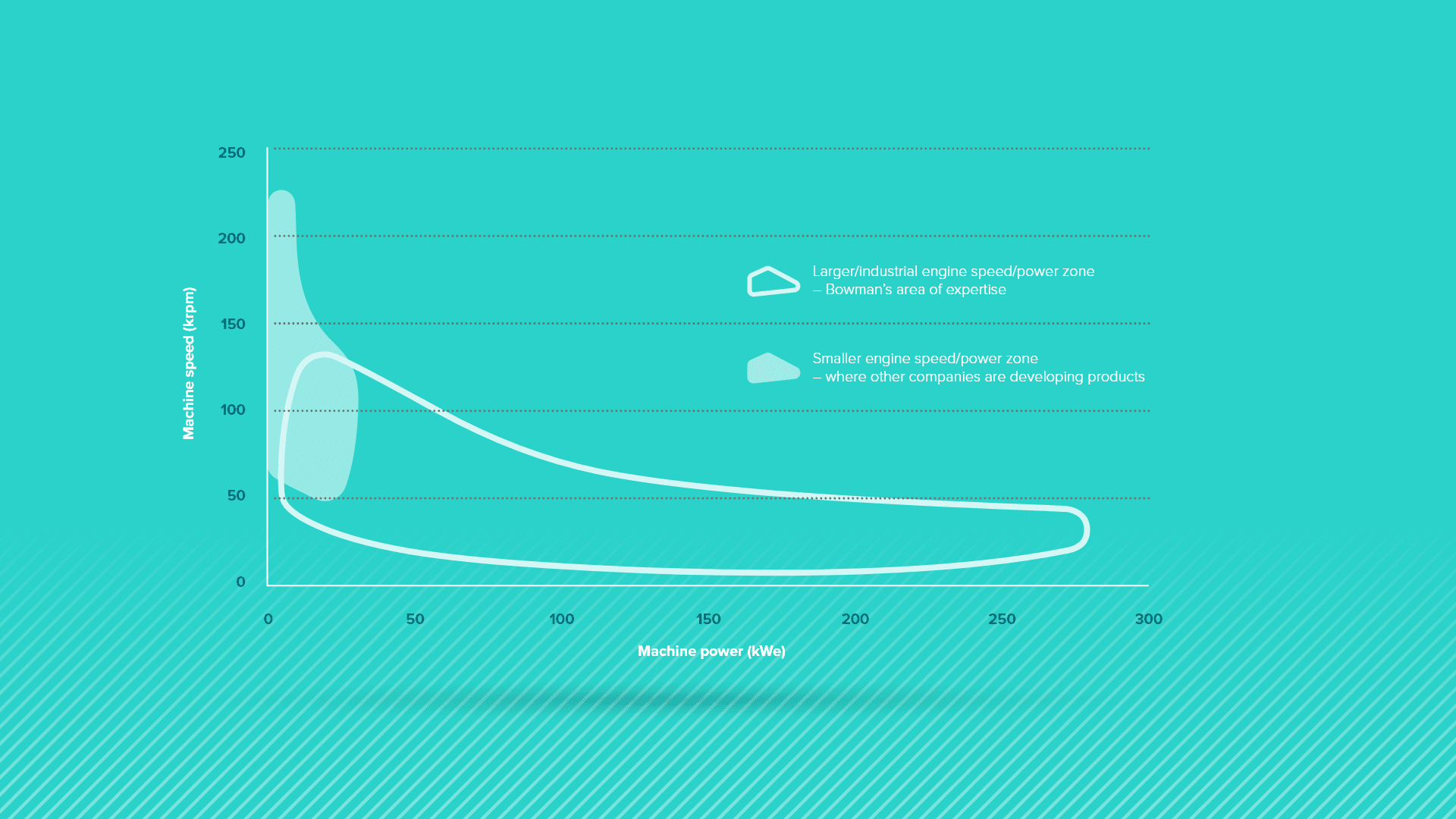
Bowman technology can make engines dance!






Through multiple product development projects, and refining our proven technology for three generations, we’ve become experts in this process.
Our world-class engineering team has expertise in a wide variety of mechanical, aerodynamic, electrical, and digital design areas including rotor dynamics, structures, thermals, software and control, electromagnetics, power electronics, and smart use of data.
The capabilities, expertise, and products of Bowman will continue to be in high demand as an ever more complex and uncertain world seeks to produce the power it needs dependably and more sustainably.
Embodied in our TorqIQ® technology, we bring together the capability and expertise usually only seen in separate turbocharger and electrical machine companies:
How they WORK
eTurbo Systems, powered by TorqIQ® technology, overcome the drawbacks of conventional turbochargers, dramatically improving the power density, efficiency, flexibility and responsiveness of an engine or fuel cell. Learn how here.
Typically, this mechanical system will deliver an optimal performance at a single steady-state point on the engine operating map, where the compressor and turbine are aerodynamically optimised along with the other engine systems.
Away from this design point, the inflexibility of the mechanical turbocharger means compromises are made and steady-state performance is typically suboptimal.
Additionally, a combination of inertia of the rotating mass and the low system efficiency at low loads, results in poor engine responsiveness when adding load. This phenomenon called "turbo lag" is detrimental to engine operation and emissions, leading to increase operating costs.
The addition of eTurbo Systems, powered by Bowman’s TorqIQ® technology, can solve both of these issues.
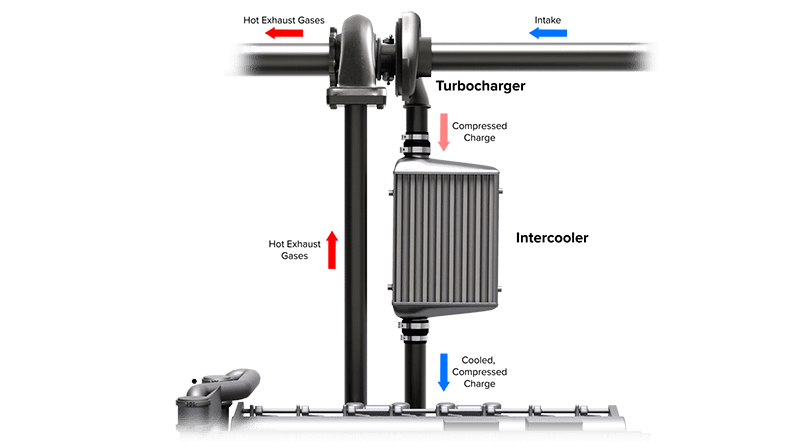


eCompressor
An electric compressor (eCompressor) is a compressor driven by a high-speed electric motor connected directly to its shaft.
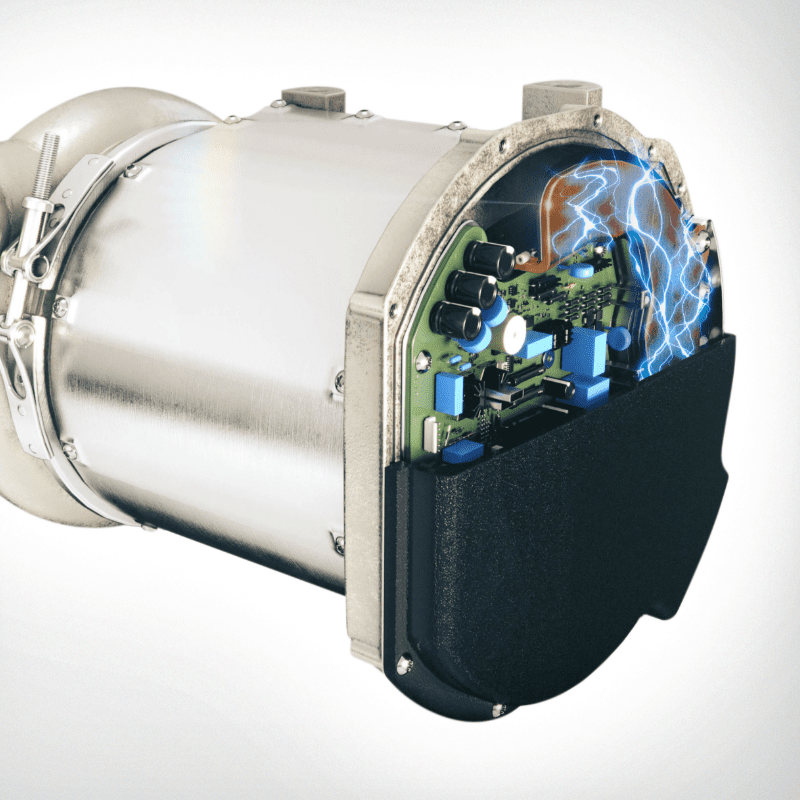

1. Augmenting the intake (series)
The eCompressor acts as a second sequential stage of turbocharging augmenting the boosted charge, but crucially independent of engine speed, thus removing any hysteresis, and therefore eliminating turbo lag and its associated problems. The eCompressor can be placed upstream (A) or downstream (B) of the main turbocharger.
Similarly eCompressors can also be used to boost fuel cells, however in this case the compressor delivers all of the air requirement for the fuel cell under all conditions whether steady-state or dynamic.






2. Augmenting the intake (parallel)
The eCompressor injects either boosted charge or air in parallel to the main turbocharger’s boost. Again, the eCompressor’s charge is independent of engine speed thus removing any hysteresis and therefore eliminating turbo lag and its associated problems.
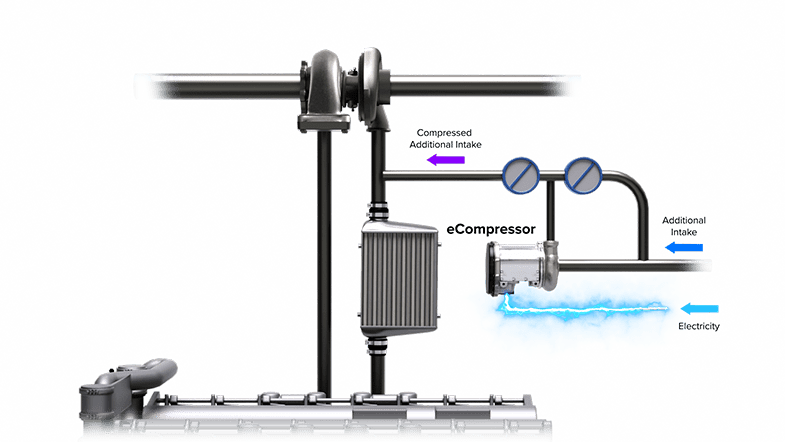


3. Augmenting the exhaust into the turbo’s turbine
Here the eCompressor is used to spool up the main turbocharger’s turbine by increasing its expansion power, rapidly accelerating the turbocharger and boost pressure delivered by the turbocharger’s own compressor. This retains the advantage of the intake-based configurations above and in addition does not require a deep controls integration or for the eCompressor to be specifically matched to a particular engine size, so is more versatile.
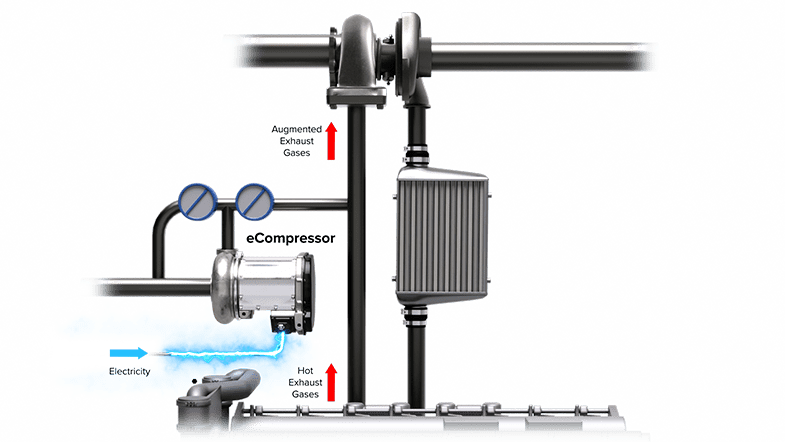


eTurbines
An electric turbine (eTurbine) is a turbine directly coupled to a high-speed electric alternator.
eTurbines are placed within the exhaust flow and used to recover waste heat from exhaust gases to produce electrical energy, improving system level efficiency.


1. Downstream application
The eTurbine is placed downstream of the engine’s own turbocharger turbine. The exhaust gases (usually wasted to atmosphere) are used to spin the alternator to produce power which can be used to improve efficiency or improve both efficiency and increase load on a system level. This process is often called Electric Turbo Compounding (as the eTurbine “compounds” the conventional turbocharger’s exhaust to salvage waste energy and convert it to electricity).



2. Wastegate application
The eTurbine is placed within the wastegate flow normally bypassed around the turbocharger's own turbine stage (usually wasted to atmosphere). Similarly, wastegate exhaust energy is used to produce power using the eTurbine which can be used to improve efficiency or improve both efficiency and increase load on a system level.
eTurbocharger
An electric turbocharger (eTurbocharger) is achieved through the addition of a high-speed electric motor/generator directly to the turbocharger’s shaft.
eTurbochargers provide the potential benefits of both eTurbine and eCompressor into a single machine, providing access to both the waste heat-recovery benefits of electric turbo compounding (by generating using the eTurbo) and instantaneous boost pressure availability (by motoring the eTurbocharger).
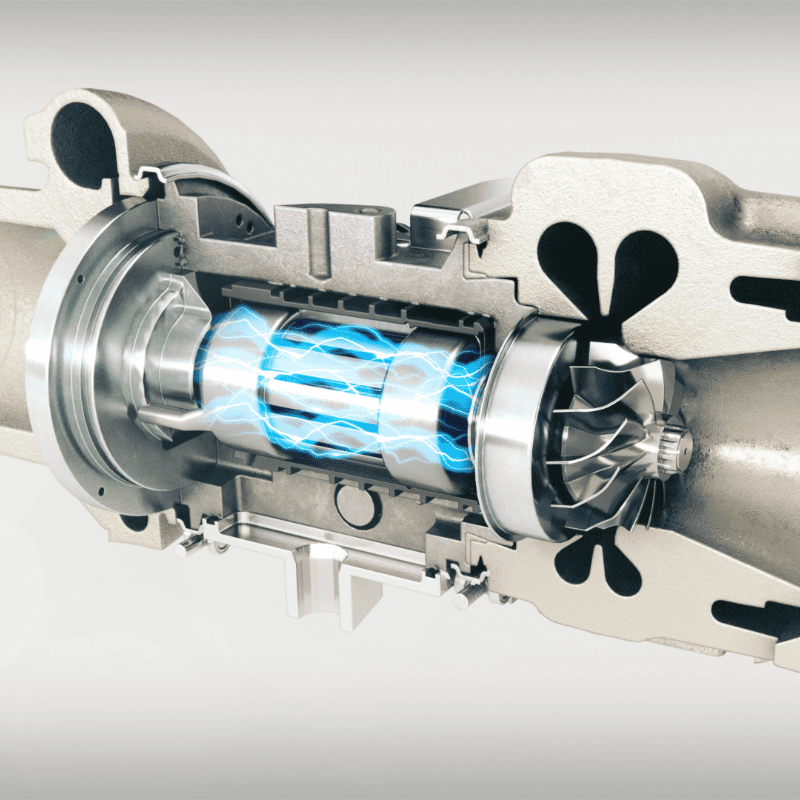


Bowman’s unparalleled TorqIQ® technology means that the eTurbocharger can be operated in three different modes of operation: as a heat recovery device, a boosting device, or enjoying the benefits of both simultaneously. With the high-speed electrical motor able to respond within milliseconds of command input, this degree of intelligent digital control facilitates more degrees of freedom of engine control strategies, offering flexibilities not possible with conventional engine technologies (e.g. optimised efficiency under all conditions, rapid load response, advanced emission control, dynamic fuel mixing, etc.)
Similarly, eTurbochargers can also be used to boost fuel cells, however in this case the air supply to the fuel cell can be augmented through heat recovery from the exhaust by means of the eTurbocharger turbine.This intelligent use of heat recovery significantly reduces the electrical load requirement for driving the fuel cell electric boosting system.



Our TECHNOLOGY
Bowman’s TorqIQ® technology brings together a unique blend of capabilities and expertise to intelligently apply torque management by integrating high-speed electrical machines (HSEMs) and power electronics in turbochargers (or separate compressors and turbines) to create smart digital eTurbo Systems
Our SPEED-POWER CURVE



This intelligent electrification enables retention (or even simplification) of the conventional base architecture of reciprocating engines, while improving system energy efficiency.
Coupled with digital expertise, TorqIQ® technology brings a new degree of freedom to engine control strategies which will enable cleaner use of today’s fuels, as well as a transition path to future carbon-free fuels.
Bowman’s eTurbo Systems, powered by TorqIQ® technology, can also be used to improve the performance and efficiency of
fuel cells.
Bowman technology can make engines dance!






Through multiple product development projects, and refining our proven technology for three generations, we’ve become experts in this process.
Our world-class engineering team has expertise in a wide variety of mechanical, aerodynamic, electrical, and digital design areas including rotor dynamics, structures, thermals, software and control, electromagnetics, power electronics, and smart use of data.
The capabilities, expertise, and products of Bowman will continue to be in high demand as an ever more complex and uncertain world seeks to produce the power it needs dependably and more sustainably.
Embodied in our TorqIQ® technology, we bring together the capability and expertise usually only seen in separate turbocharger and electrical machine companies:
How they WORK
eTurbo Systems, powered by TorqIQ® technology, overcome the drawbacks of conventional turbochargers, dramatically improving the power density, efficiency, flexibility and responsiveness of an engine or fuel cell. Learn how here.
Typically, this mechanical system will deliver an optimal performance at a single steady-state point on the engine operating map, where the compressor and turbine are aerodynamically optimised along with the other engine systems.
Away from this design point, the inflexibility of the mechanical turbocharger means compromises are made and steady-state performance is typically suboptimal.
Additionally, a combination of inertia of the rotating mass and the low system efficiency at low loads, results in poor engine responsiveness when adding load. This phenomenon called "turbo lag" is detrimental to engine operation and emissions, leading to increase operating costs.
The addition of eTurbo Systems, powered by Bowman’s TorqIQ® technology, can solve both of these issues.



eCompressor
An electric compressor (eCompressor) is a compressor driven by a high-speed electric motor connected directly to its shaft.


1. Augmenting the intake (series)
The eCompressor acts as a second sequential stage of turbocharging augmenting the boosted charge, but crucially independent of engine speed, thus removing any hysteresis, and therefore eliminating turbo lag and its associated problems. The eCompressor can be placed upstream (A) or downstream (B) of the main turbocharger.
Similarly eCompressors can also be used to boost fuel cells, however in this case the compressor delivers all of the air requirement for the fuel cell under all conditions whether steady-state or dynamic.






2. Augmenting the intake (parallel)
The eCompressor injects either boosted charge or air in parallel to the main turbocharger’s boost. Again, the eCompressor’s charge is independent of engine speed thus removing any hysteresis and therefore eliminating turbo lag and its associated problems.



3. Augmenting the exhaust into the turbo’s turbine
Here the eCompressor is used to spool up the main turbocharger’s turbine by increasing its expansion power, rapidly accelerating the turbocharger and boost pressure delivered by the turbocharger’s own compressor. This retains the advantage of the intake-based configurations above and in addition does not require a deep controls integration or for the eCompressor to be specifically matched to a particular engine size, so is more versatile.



eTurbines
An electric turbine (eTurbine) is a turbine directly coupled to a high-speed electric alternator.
eTurbines are placed within the exhaust flow and used to recover waste heat from exhaust gases to produce electrical energy, improving system level efficiency.


1. Downstream application
The eTurbine is placed downstream of the engine’s own turbocharger turbine. The exhaust gases (usually wasted to atmosphere) are used to spin the alternator to produce power which can be used to improve efficiency or improve both efficiency and increase load on a system level. This process is often called Electric Turbo Compounding (as the eTurbine “compounds” the conventional turbocharger’s exhaust to salvage waste energy and convert it to electricity).



2. Wastegate application
The eTurbine is placed within the wastegate flow normally bypassed around the turbocharger's own turbine stage (usually wasted to atmosphere). Similarly, wastegate exhaust energy is used to produce power using the eTurbine which can be used to improve efficiency or improve both efficiency and increase load on a system level.
eTurbocharger
An electric turbocharger (eTurbocharger) is achieved through the addition of a high-speed electric motor/generator directly to the turbocharger’s shaft.
eTurbochargers provide the potential benefits of both eTurbine and eCompressor into a single machine, providing access to both the waste heat-recovery benefits of electric turbo compounding (by generating using the eTurbo) and instantaneous boost pressure availability (by motoring the eTurbocharger).



Bowman’s unparalleled TorqIQ® technology means that the eTurbocharger can be operated in three different modes of operation: as a heat recovery device, a boosting device, or enjoying the benefits of both simultaneously. With the high-speed electrical motor able to respond within milliseconds of command input, this degree of intelligent digital control facilitates more degrees of freedom of engine control strategies, offering flexibilities not possible with conventional engine technologies (e.g. optimised efficiency under all conditions, rapid load response, advanced emission control, dynamic fuel mixing, etc.)
Similarly, eTurbochargers can also be used to boost fuel cells, however in this case the air supply to the fuel cell can be augmented through heat recovery from the exhaust by means of the eTurbocharger turbine.This intelligent use of heat recovery significantly reduces the electrical load requirement for driving the fuel cell electric boosting system.



